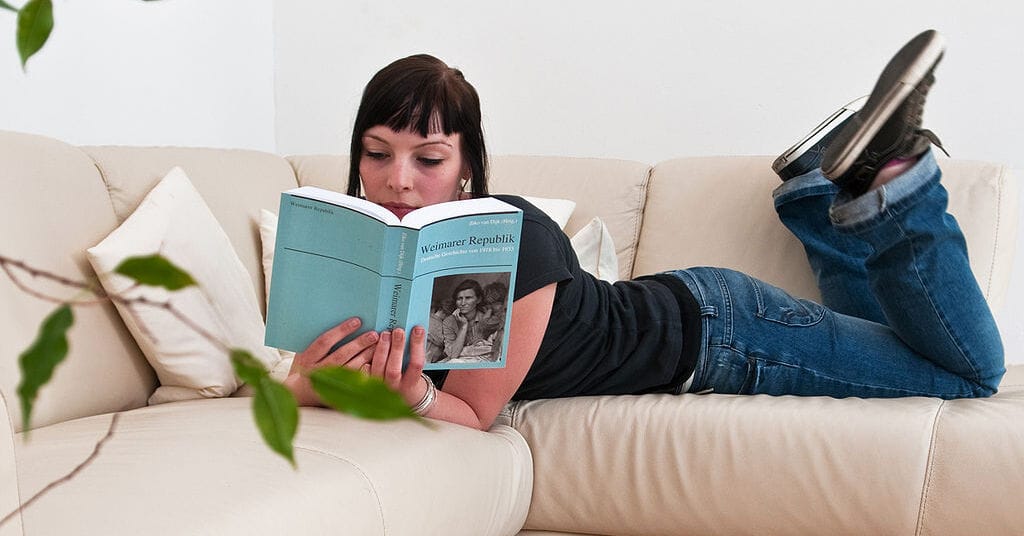There is a widespread belief that reading while lying down harms vision and provokes early myopia. We decided to check whether such fear is justified.
Information about the dangers of reading while lying down can be found at pages shops points And lenses, this is also written about in various Media And blogs. Reported, that reading in such a position “can contribute to the progression of any existing ocular abnormality: farsightedness, myopia, strabismus, astigmatism.” In addition to harm to the eyes, other negative consequences of this habit are listed: suffer spine and back muscles, getting worse blood circulation and “congestion in the cerebral cortex” occurs, which, in turn, leads to headaches and dizziness. Moreover, such a reading called unproductive: “When a person takes a lying position, the brain receives a signal to rest. In this state, information is poorly perceived. In this regard, reading will not bring any benefit if we talk about the cognitive aspect.”
To figure out whether lying down reading can damage your vision, you first need to understand how our eyes work. Eyeball consists of of three membranes: outer, choroid and retina, as well as internal contents. The outer layer, the sclera, protects the eye from external influences. The front part of the sclera - the cornea - is transparent, through which light waves enter the eye. Six extraocular muscles are attached to the sclera to change the direction of gaze. The second membrane - the vascular one - is penetrated by blood vessels through which nutrients enter the eye and metabolic products are removed. The choroid includes the iris, ciliary body and choroid. In the center of the iris there is a round hole - the pupil, whose size can vary depending on the intensity of the light. The ciliary body contains the accommodative (also called ciliary or ciliary) muscle, the main function of which is to regulate the shape of the lens. The lens is a biconvex lens located just behind the pupil. By changing the shape of the lens, we can clearly see objects located both near and far. The third layer of the eye, the retina, contains light-sensitive receptors: rods and cones, which also allow us to distinguish colors and their shades.
For the reading process to be possible, it is necessary that the cornea is healthy, the muscles that provide direction of gaze are working and allow the gaze to move across the page, the shape of the lens is optimal for distinguishing letters at the required distance, and there is sufficient lighting for reading. Most anatomically correct distance from the book to the eye - about 35–40 cm, and the angle of inclination should be 60°. If you set a goal, then, in principle, it is possible to maintain such a distance from the book to the eyes even in a lying position. In this case, lying on your back, you will have to stretch your arms quite high and hold them in this position for a long time, and while lying on your stomach, you will have to bend your spine to a significant extent. Maintaining the required reading angle will be much more difficult. Most likely, in a lying position, both of these rules will be violated. However, neglecting them won't lead to significant consequences for vision.
Reading while lying down may cause eye strain, or asthenopia. Moreover, asthenopia is not a disease, but just a condition. It can be compared to how muscles get tired after a long walk or intense workout. It passes in itself, you just need to give the body the necessary rest. At the same time, if you ignore the symptoms of eye fatigue (blurred vision, dry eyes, lacrimation), then they may well develop. be added and headache. However, with symptoms of asthenopia, according to statistics Medical Center named after. Fedorov, up to 75% of the population faces, primarily due to working on a computer. Irreversible eye damage from reading while lying down doesn't happen.
Moreover, there is limited evidence that this posture is even beneficial for reading. In 2016, Finnish scientists published results of a three-year observation of 240 schoolchildren (average age 10.9 years) with existing myopia (myopia). It turned out that the vision of those who preferred to read while sitting fell by an average of 3.58 diopters, for those who read while lying on their stomachs - by 3.17, but for those who read while lying on their backs - by only 2.35. Thus, reading while lying down was associated with less progression of existing myopia.
The assertion that when reading lying down, information is absorbed worse is also unfounded. Researchers from the University of California, Davis wondered The question is which students are more successful - those who prefer a desk, or those who work from bed. It turned out that there was no difference in the average score between them. With their conclusions agree and medical practitioners like Atul Malotra, internist and MD: “Neither lying nor sitting affects the functioning of your brain, body position simply does not matter.” Ergonomics specialist (the science of adapting job responsibilities, jobs, objects and objects of work, as well as computer programs for the safest and most effective work of a worker, based on the physical and mental characteristics of the human body) from the academic medical center of the University of California at San Diego Janice Fletcher speaks, that the most neutral pose, in which our body experiences the least stress, is standing with our arms down. But the second most neutral position is lying on your back with your arms outstretched relaxed. At the same time, the specialist notes, these poses are not suitable for reading. If you want to read in bed, she recommends doing it on your back, with pillows under your head, upper back and arms, and placing the book as close to eye level as possible.
Reading while lying down is also not on the list of reasons for the development of myopia. Basic factors risk - genetics and environment. By observations scientists, if one of the parents is diagnosed with myopia, then with a 25% probability it will manifest itself in the child. If both parents are myopic, the risk of developing pathology in the child increases to 50%. Among all environmental factors, the most significant is timespent in the fresh air.
Thus, reading while lying down does not lead to irreversible visual impairment. The maximum that can threaten those who like to read in a horizontal position is eye fatigue, which, to be fair, we note that can also occur when reading in any other position, especially if the required distance between the book and the eyes is not maintained. Moreover, while reading, as well as, for example, working at a computer, it is important to observe the so-called "20-20-20 rule" - every 20 minutes be distracted for 20 seconds. and look at an object 20 feet away (about 6 m). In addition, there is evidence that for adolescents with existing visual impairments, reading while lying on their back may even help slow the progression of the disease.
Cover image: Julia Spranger, CC BY 3.0, via Wikimedia Commons

Mostly not true
Read on the topic:
- Is it true that reading from a screen damages your eyesight?
- Is it true that men have less developed peripheral vision than women?
- Is it true that earlobe piercing can affect your vision?
- Is it true that carrots that improve eyesight are a myth created by the British to hide the use of radar?
If you find a spelling or grammatical error, please let us know by highlighting the error text and clicking Ctrl+Enter.






